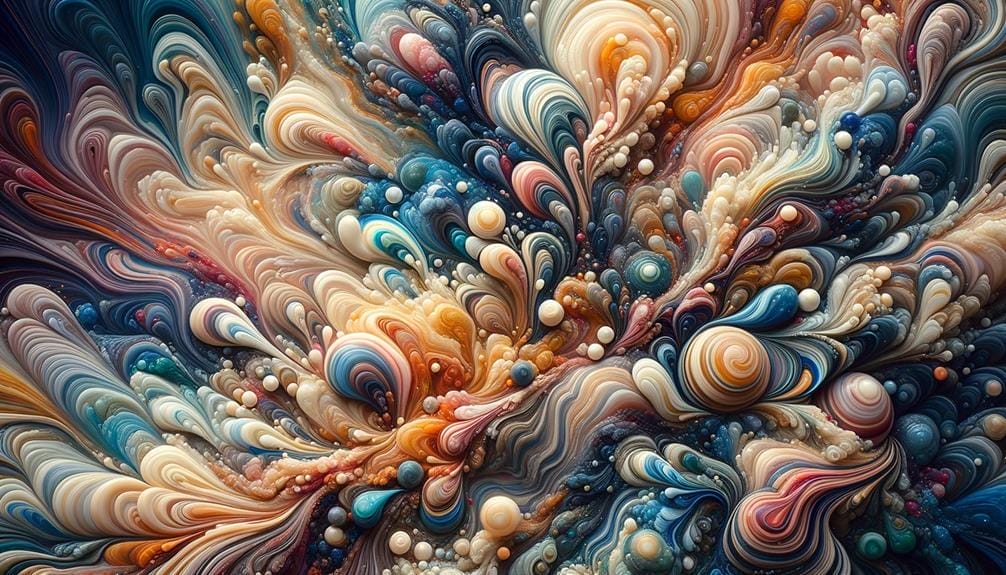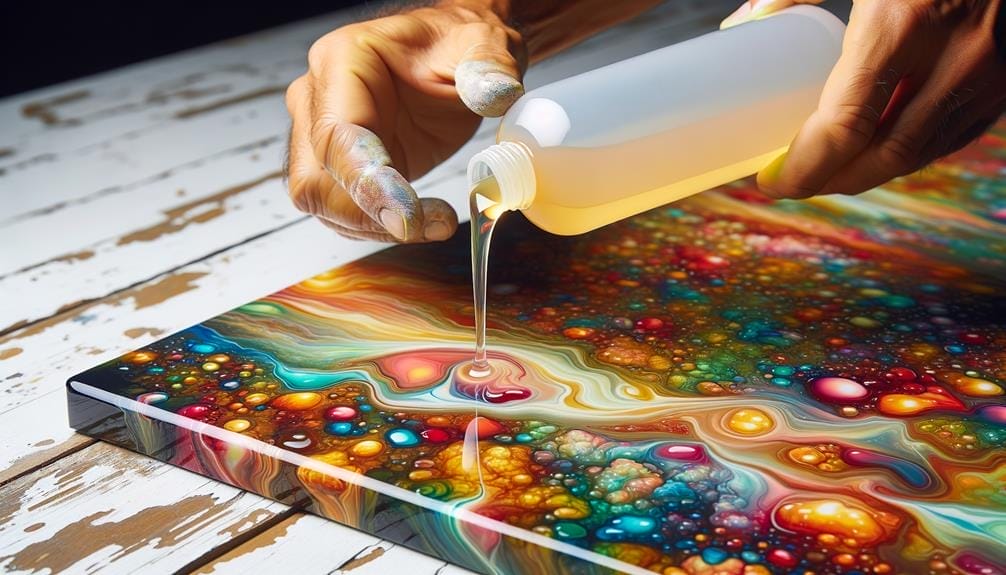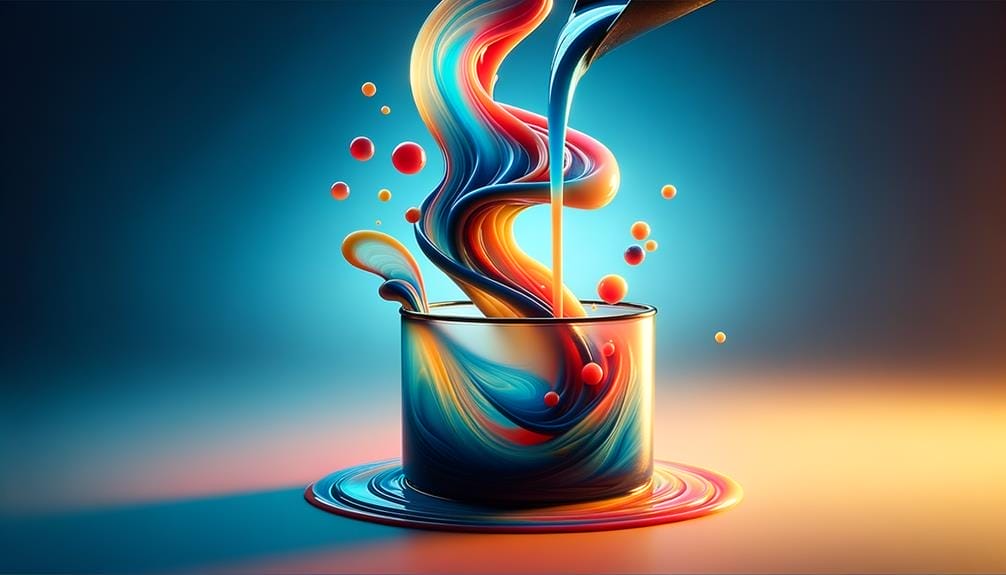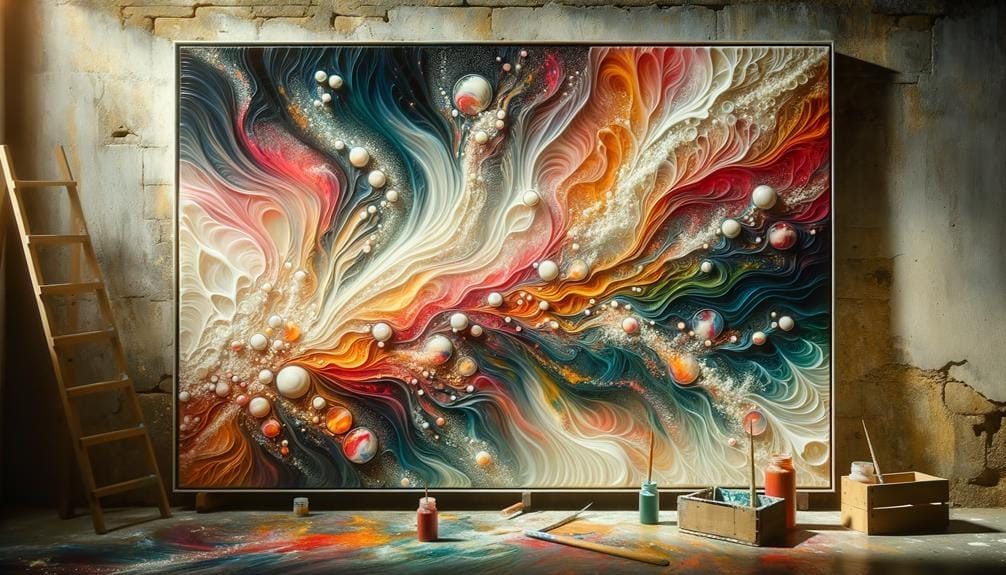Are you looking to add a pop of color and creativity to your resin projects? Colored resin techniques offer a world of possibilities for creating beautiful and unique pieces that are sure to catch the eye. From vibrant pigments and dyes to mesmerizing effects and patterns, there is so much to explore.
In this discussion, we will delve into the different coloring techniques, the importance of using the right colorants, and tips for achieving stunning transparent and opaque colors. Get ready to unlock the secrets of colored resin and elevate your artistic creations to a whole new level.
Key Takeaways
- Consider the desired effect and substrate color for a vibrant and uniform result.
- Pigments and dyes are two options for achieving resin colors
- Experiment with different techniques and combinations for unique results
- Mix different pigments into separate resin batches for multiple shades
Choosing the Right Resin Colors
When selecting the perfect resin colors, it’s essential to consider the desired effect and the substrate color to achieve a vibrant and uniform result. Resin colors can be achieved using either pigments or dyes.
Pigments are available in powder form and can create irregular patterns, shimmer, or pearlescent effects in the resin. On the other hand, liquid resin dyes add a smooth, even tone without shimmer and can be gradually added to achieve the desired color depth. To ensure color intensity and depth, it’s recommended to use premium powder pigments and resin dyes from Pigmently.
Color intensity can also be controlled by the amount of pigment or dye added to the resin. Mica powder pigments, for example, become darker and less translucent with more added, giving you greater control over color intensity and effect. When choosing between liquid dyes and powder pigments, consider the substrate color and the desired effect.
If you want a brighter and more uniform color, liquid dyes are a better choice. For a more unique and textured look, powder pigments can provide the desired effect. It is important to note that the curing process can affect the color of the resin. Some colors may appear darker or lighter after curing, so it’s recommended to test a small sample before applying it to the final project.
Using Pigments and Dyes for Colorful Effects
To create stunning and vibrant resin projects, understanding how to use pigments and dyes effectively is crucial. There are different methods for adding color to clear resin, and the amount of colorant used can greatly impact the final result.
When using pigments, such as epoxy powder pigments, you can achieve irregular patterns, shimmer, or pearlescent effects. On the other hand, liquid resin dyes add smooth, even tones with no shimmer.
When using liquid dyes, it’s important to gradually add them to the resin to achieve the desired color depth. Keep in mind that mica powder pigments become darker and less translucent with more added, so be mindful of the proportions.
If you want to create multiple shades with epoxy powder pigments, mix each pigment into its resin batch for different colors. Then, pour the tinted batches simultaneously to create attractive resin patterns.
Before starting a colorful epoxy project, consider the brightness and desired effect you want to achieve. Choose between pigments and dyes based on these factors. If you want more light transmission or brighter hues, use a smaller amount of pigment or dye.
To source reliable pigments and dyes, you can check out Pigmently, which offers premium powder pigments and resin dyes. Another option is the UltraClear Epoxy store, known for its high-quality epoxy pigments and dyes.
Experiment with different colorants and techniques to create unique and eye-catching resin projects.
Exploring Different Coloring Techniques
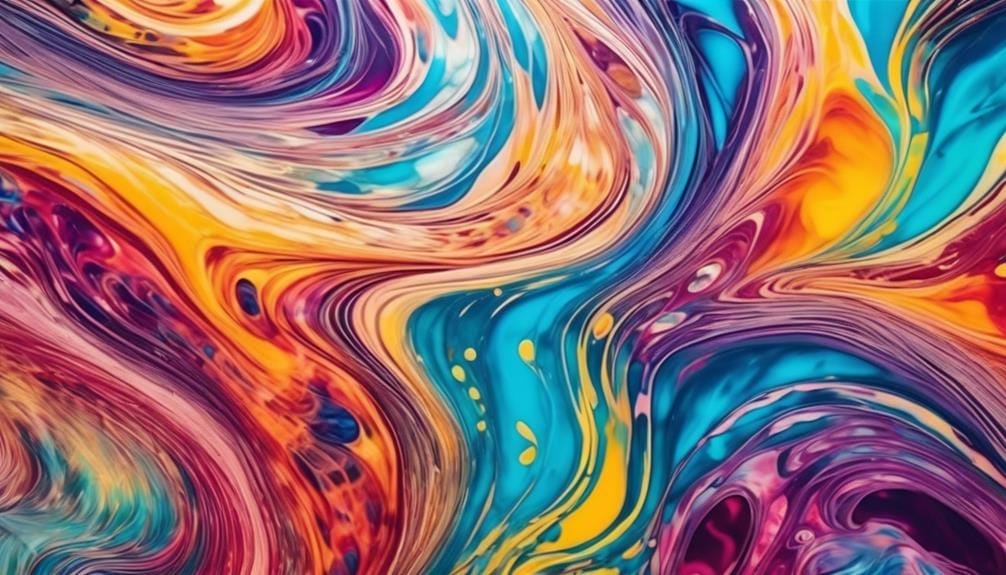
There are various techniques that you can explore to add color to resin and create visually captivating projects. Here are three techniques that you can try:
- Alcohol Ink:
Alcohol ink is a popular choice for coloring epoxy resin. These inks are highly pigmented and come in a wide range of colors. To use alcohol ink, drop a few drips into the resin and mix thoroughly. The result is a vibrant and transparent dye that can create stunning effects in your colored resin projects.
- Mica Powders:
Mica powders are finely ground minerals that can be mixed with epoxy resin to add a metallic or pearlescent effect. These powders come in a variety of colors and can be mixed to create custom shades. Mix the mica powder into the resin until you achieve the desired color. The result is a resin that shimmers and shines when exposed to light.
- Acrylic Paint:
Acrylic paints are another versatile option for coloring epoxy resin. These paints come in a wide range of colors and can be mixed to create custom shades. To color epoxy with acrylic paint, mix the paint into the resin until it’s evenly distributed. Keep in mind that acrylic paints can make the resin opaque, so consider using them when you want a solid, colored resin effect.
Remember to experiment with different techniques and combinations to achieve the desired effect. Whether you choose alcohol ink, mica powders, or acrylic paint, these coloring techniques will help you create stunning and unique colored resin projects.
Tips for Achieving Transparent and Opaque Colors
To achieve transparent colors in resin, you can start by mixing color pigments into the resin before pouring it into your mold. This allows the pigments to blend evenly and create a translucent effect.
Another technique is layering different colors of resin, which can create depth and add transparency when light passes through the layers.
On the other hand, if you want opaque colors, you can use a higher concentration of color pigments or add an opaque white pigment to the resin.
Mixing Color Pigments
For achieving transparent and opaque colors in your resin projects, it’s crucial to mix color pigments carefully with precision and attention to detail. Here are three tips to help you achieve the desired color in your resin batches:
- Gradually add liquid dyes: To achieve the desired color depth and smooth, even tones, it’s recommended to add liquid dyes gradually. This allows you to control the intensity of the color and avoid adding too much dye, which can’t be undone.
- Use premium powder pigments and resin dyes: To ensure high-quality results and reliable color intensity, it’s a good idea to use premium powder pigments and resin dyes from reputable sources like Pigmently. This will help you achieve vibrant and long-lasting colors in your resin projects.
- Mix different pigments into separate resin batches: If you want to create multiple shades, consider mixing different pigments into separate resin batches. This will allow you to experiment with different colors and pouring techniques, resulting in attractive patterns. Just make sure to consider epoxy resin’s working time and the desired effects when choosing the pigments.
Layering Different Resin Colors
To achieve both transparent and opaque colors in your resin projects, you can utilize layering techniques that involve strategically combining different resin colors.
When layering resin, it’s important to use a small amount of coloring resin to achieve the desired effect. Start by mixing a small batch of transparent resin and pour it into your mold.
Once the first layer has partially cured, you can add a different color of resin on top. This creates a distinct separation between the layers and allows light to pass through, creating a transparent effect.
If you want to achieve an opaque color, add a larger amount of resin with a different color on top of the first layer.
Make sure the colors you choose are compatible with resin to ensure proper curing and a successful outcome.
Avoiding Common Mistakes in Coloring Resin
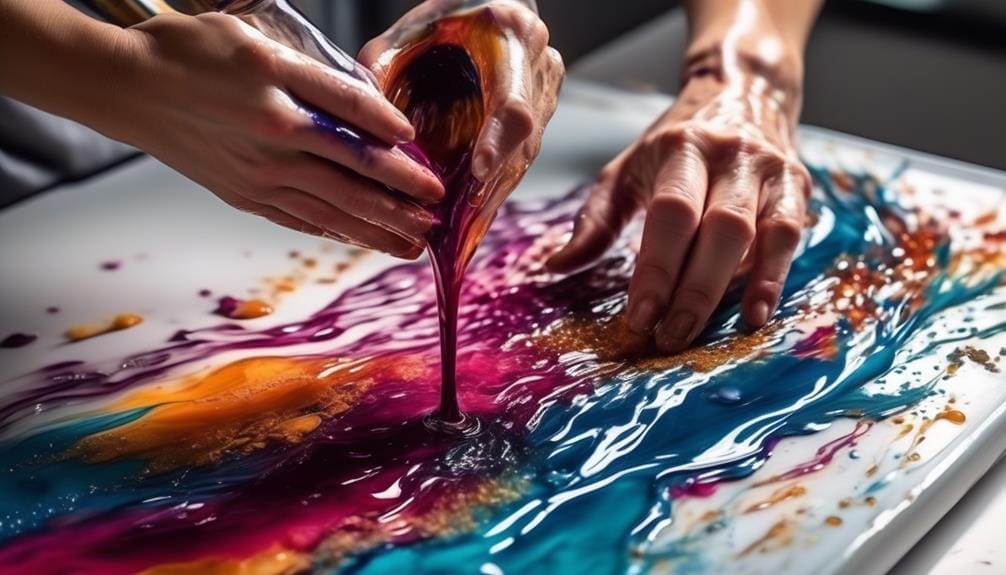
To avoid common mistakes when coloring resin, it’s important to carefully consider the amount of liquid dye you add, as adding too much at once can lead to over-saturation that can’t be undone. Here are three important tips to keep in mind:
- Gradually add the liquid dye: Instead of adding a large amount of dye all at once, it’s best to add it gradually. This allows you to control the color depth and prevent over-saturation. By adding small increments and mixing well, you can achieve the desired color without risking the quality of your resin.
- Mix pigments into separate resin batches: Different pigments may have varying working times and can affect the curing process differently. To ensure consistent results, it’s recommended to mix each pigment into its resin batch. This way, you can avoid older batches from curing before you’re ready to use them.
- Consider the substrate color: The color of the surface or substrate that you pour your resin onto can affect the final result. If the substrate color is too dark or too light, it may impact the appearance of the resin. Taking the time to choose the right substrate color can enhance the overall look of your resin artwork or table top.
Frequently Asked Questions About Coloring Resin
Have questions about coloring resin? Here are some frequently asked questions to help you navigate the process.
Q: Can I use food coloring to color resin?
A: Yes, you can use food coloring to color resin. However, keep in mind that food coloring is water-based so that it may affect the curing process of the resin. It’s recommended to use resin-specific pigments or dyes for the best results.
Q: How much coloring should I use for a resin piece?
A: The amount of coloring you should use depends on the desired intensity of color. Start with a small amount and gradually add more until you achieve the desired shade. Keep in mind that a little goes a long way, and using too much coloring can affect the resin’s curing process.
Q: How do I mix the coloring into the resin?
A: Make sure to thoroughly mix the coloring into the resin using a stir stick or a silicone spatula. Mix until the color is evenly distributed throughout the resin. Avoid over-mixing, as it can introduce air bubbles into the mixture.
Q: Can I color a table top with resin?
A: Yes, you can color a table top with resin. However, it’s important to still pass a layer of clear resin over the colored layer to ensure a smooth and glossy finish.
Q: Can I mix different colors of resin in one batch?
A: Yes, you can mix different colors of resin in one batch to create unique color combinations. Just make sure to adjust the ratios of each color to achieve the desired shade.
Frequently Asked Questions
How Can You Color Resin?
You have several options for color resin. You can use resin dyes, mix pigments into the resin, create gradient effects, use alcohol inks, add glitter, experiment with different color ratios, incorporate natural materials, use powdered pigments, use resin tints, and layer different colored resins.
How Do You Make Colorful Resin Art?
To make colorful resin art, start by experimenting with resin pigments, alcohol ink, resin dye, mica powder, resin tints, epoxy colorants, and more. Use techniques like resin marbling, swirls, gradients, and ombre to create stunning designs.
How to Do Multi-Color Epoxy Resin?
To achieve a multi-color epoxy resin effect, start by creating a gradient effect using alcohol ink. Mix different pigments and incorporate glitter for added sparkle. Layer colors, add metallic accents, and create marbled patterns. Experiment with different color combinations and consider incorporating natural materials like flowers or leaves. Use dye powders for vibrant colors.
Can You Color Resin With Acrylic Paint?
Yes, you can color resin with acrylic paint! It’s a popular technique for resin color mixing. Experiment with different acrylic paint brands to achieve vibrant colors, and try blending multiple colors for unique effects. Don’t forget to troubleshoot common issues!
Conclusion
In conclusion, colored resin techniques offer endless possibilities for creating vibrant and unique resin pieces. By using a combination of pigments, dyes, and additives, artists can achieve stunning colors, effects, and patterns.
One interesting statistic to note is that using thermochromic pigments, which change color with temperature, has gained popularity in resin art, with a 20% increase in sales over the past year.
With the right colorants and techniques, artists can truly bring their resin creations to life.

